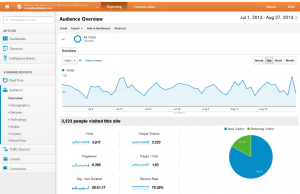So What’s Changed Since the Re-Launch?
 Back in June of this year you may recall that I launched a new design for this blog. With the intention of increasing this blog’s readership I opted for a WordPress template that was responsive, with good UI and strong SEO functionality.
Back in June of this year you may recall that I launched a new design for this blog. With the intention of increasing this blog’s readership I opted for a WordPress template that was responsive, with good UI and strong SEO functionality.
I always like to keep a close eye on the stats and see how the blog is performing, but over the last eight weeks I’ve noticed some very significant changes in the data:
-
The blog’s Alexa Rank has gone from 1.1 million to 500k
-
Web visits have grown by 8%
-
Bounce rate has decreased by 7%
-
Average visit duration has gone up 4%
-
Tablet and mobile visits have increased by 35%
These Outputs and Outtakes have resulted in the following Outcomes:
-
AdSense revenues have doubled (admittedly, from a small starting point)
-
Blog comments have increased dramatically
-
I’m receiving more and more pitches and sponsored post offers
What can I attribute this change to? As with many things in life asking the right questions is absolutely crucial.
Lets start with Alexa Rank first. My blog traffic has increased incrementally, but the Alexa Rank has improved dramatically. Is the difference between being ranked 1.1 million and 500k actually very small? Or are people becoming more selective in what they read and abandoning small blogs in favour of established media sites? I know for a fact several industry leaders have recently stopped blogging .
These are just two possible explanations for the huge leap in Alexa Rank (to calculate your website’s rank just enter its domain name into the tool) despite only a modest increase in web visits. I’ve also checked and there’s been no update to the way Alexa Rank is calculated. So what could it be?
Another possible explanation could be to do with engagement metrics and SEO. As you can see from the data, the new design has better engagement figures than my last blog design and has more written content on the homepage (as opposed to images), which undoubtedly will enhance search engine visibility. Does Alexa now use these figures in its ranking system?
One thing is for sure; by choosing a responsive design I’ve managed to provide readers with the optimum viewing experience. This has undoubtedly had a positive impact on pageviews, bounce rate and visit duration.
The increasing number of visits from mobile and tablet devices is part of a much wider trend, rather than as a result of the design. But what it does show is that a responsive design is no longer a ‘nice to have’, but a commercial imperative.
I appreciate this post probably raises more questions than it answers, but one thing is crystal clear. If your website does not have a responsive design, your customers will find somewhere that does. If you want people to return, share and recommend your website, you must provide people with the best possible experience which means serving the right content at exactly the right time on the right device.














